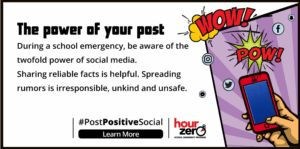In today’s fast-moving digital world, misinformation during school emergencies is no longer a side issue—it’s one of the biggest threats to effective crisis response. As incidents unfold, social media can connect communities, but it can just as easily amplify confusion, fear, and harmful rumors.
At Hour-Zero, we know that clear, coordinated, and credible communication is as vital as any physical security measure. That’s why we created #PostPositiveSocial—a risk communications campaign that helps schools and families use social media responsibly, protect students and staff, and build trust when it matters most.
What Is #PostPositiveSocial?
#PostPositiveSocial is one of Hour-Zero’s risk communications initiatives focused on upholding honesty, transparency, and respect on social media during school emergencies. It encourages thoughtful engagement throughout the year, helping foster open dialogue between schools, districts, and their stakeholders.
The goal is to reduce the spread of rumors, false facts, and inaccurate posts that can cause harm during critical incidents. By promoting positive, fact-based communication, the campaign complements Hour-Zero’s broader emergency response and crisis communication tools.
Resources available to clients through HZ Online include:
- Social Media campaign materials
- Factsheets
- Web-based guides for schools and parents
Social Media’s Double-Edged Sword
Social media has transformed how schools communicate with families. During emergencies, the public often becomes an active participant—sharing content, opinions, and personal experiences in real time. This shift gives stakeholders a powerful role as both recipients and sources of information.
However, research has shown that stress can impair decision-making and information processing (Starcke & Brand, 2012). In the heat of a school-related emergency, parents and guardians may unintentionally spread misinformation as they try to make sense of unfolding events. A study by Lee & Ma (2012) highlights that many users share news not for its quality, but as a way to feel connected—a tendency that can blur fact from fiction in high-stakes situations.
The Risks of Misinformation in School Emergencies
When inaccurate information spreads during a crisis, the consequences are real:
- Delayed or inappropriate responses. Parents, staff, or students may take actions based on bad information, jeopardizing safety.
- Heightened stress and confusion. Rumors often fuel fear faster than facts, making it harder for people to follow emergency procedures.
- Diversion of critical resources. Emergency responders may be pulled away from real threats to investigate or manage false reports.
- Erosion of trust. Once confidence in official communications breaks down, it can be difficult to restore.
How #PostPositiveSocial Helps
#PostPositiveSocial aligns with proven crisis communication principles:
- Be First, Be Credible (CDC): Get accurate information out early to stay ahead of rumors.
- Negative Dominance Avoidance (Covello et al.): Promote calm, positive messaging instead of fear-based posts.
- Trust Determination Theory (Covello & Sandman): Build and maintain public trust through consistency and transparency.
The campaign applies Framing Theory (Entman) to emphasize constructive social media behaviors while discouraging harmful ones. It also accounts for the dynamics of Rumor Theory (Allport & Postman), recognizing that people often share improvised information in times of uncertainty.
By providing tools such as fact sheets, sample posts, and campaign materials, #PostPositiveSocial helps schools and families work together to promote responsible social media use.
The Power of Consistent Messaging
Misinformation often stems from confusion about emergency terms. For example, “Secure” (a precautionary status limiting outside activity) is often misreported as a “Lockdown” (a more serious, shelter-in-place response). This small error can cause unnecessary panic.
Hour-Zero helps schools standardize language and educate both staff and families, promoting clear, consistent, and reassuring communication during emergencies.
A Shared Responsibility
Misinformation in school emergencies isn’t just a communications issue—it’s a safety issue. #PostPositiveSocial gives schools and families the tools to create a social media culture that informs, reassures, and protects.
Explore #PostPositiveSocial resources today on HZ Online and join the movement to build safer, stronger school communities through positive, responsible communication.
If you would like to learn more about the campaign or other communications resources available through Hour-Zero, please don’t hesitate to reach out to connect.
References
- Allport, G. W., & Postman, L. The Psychology of Rumor.
- Covello, V. T., Peters, R. G., Wojtecki, J. G., & Hyde, R. C. Risk communication, the West Nile Virus epidemic, and bioterrorism: Responding to the communication challenges posed by the intentional or unintentional release of a pathogen in an urban setting. Journal of Urban Health, 78(2), 382–391.
- Covello, V. T., & Sandman, P. M. Risk communication: Evolution and revolution. In A. Wolbarst (Ed.), Solutions to an Environment in Peril (pp. 164–178).
- Entman, R. M. Framing: Toward clarification of a fractured paradigm. Journal of Communication, 43(4), 51–58.
- Lee, C. S., & Ma, L. News sharing in social media: The effect of gratifications and prior experience. Computers in Human Behavior, 28(2), 331–339.
- Starcke, K., & Brand, M. Decision making under stress: A selective review. Neuroscience & Biobehavioral Reviews, 36(4), 1228–1248.
- CDC. Crisis and Emergency Risk Communication (CERC).

